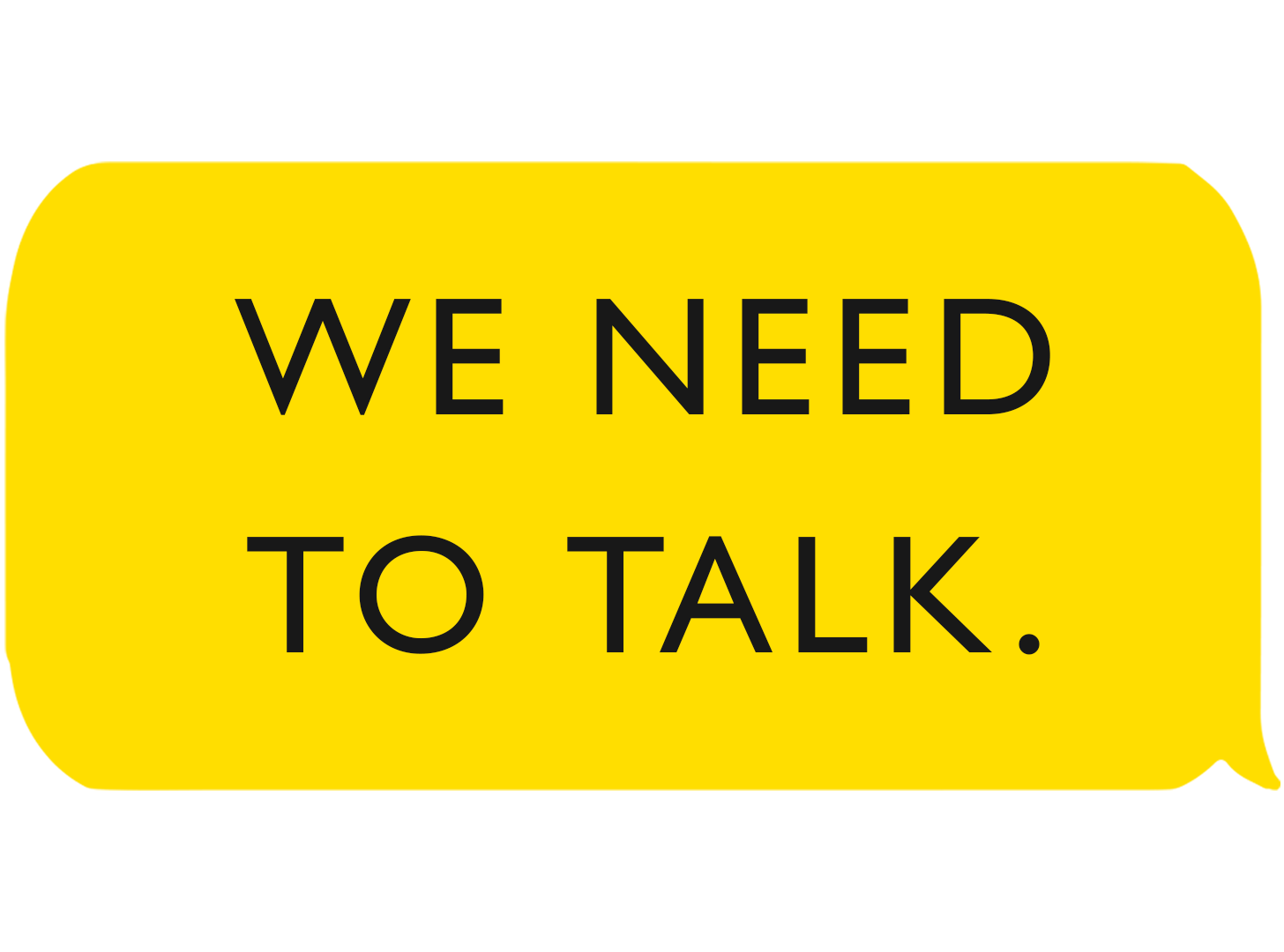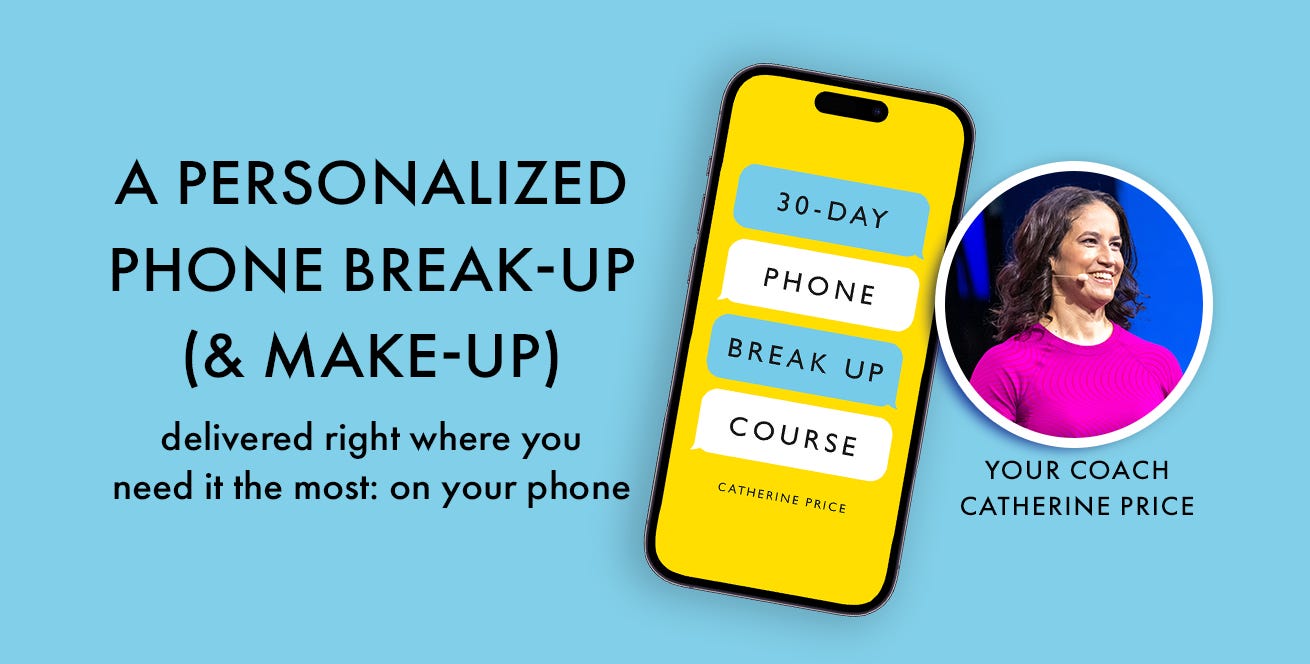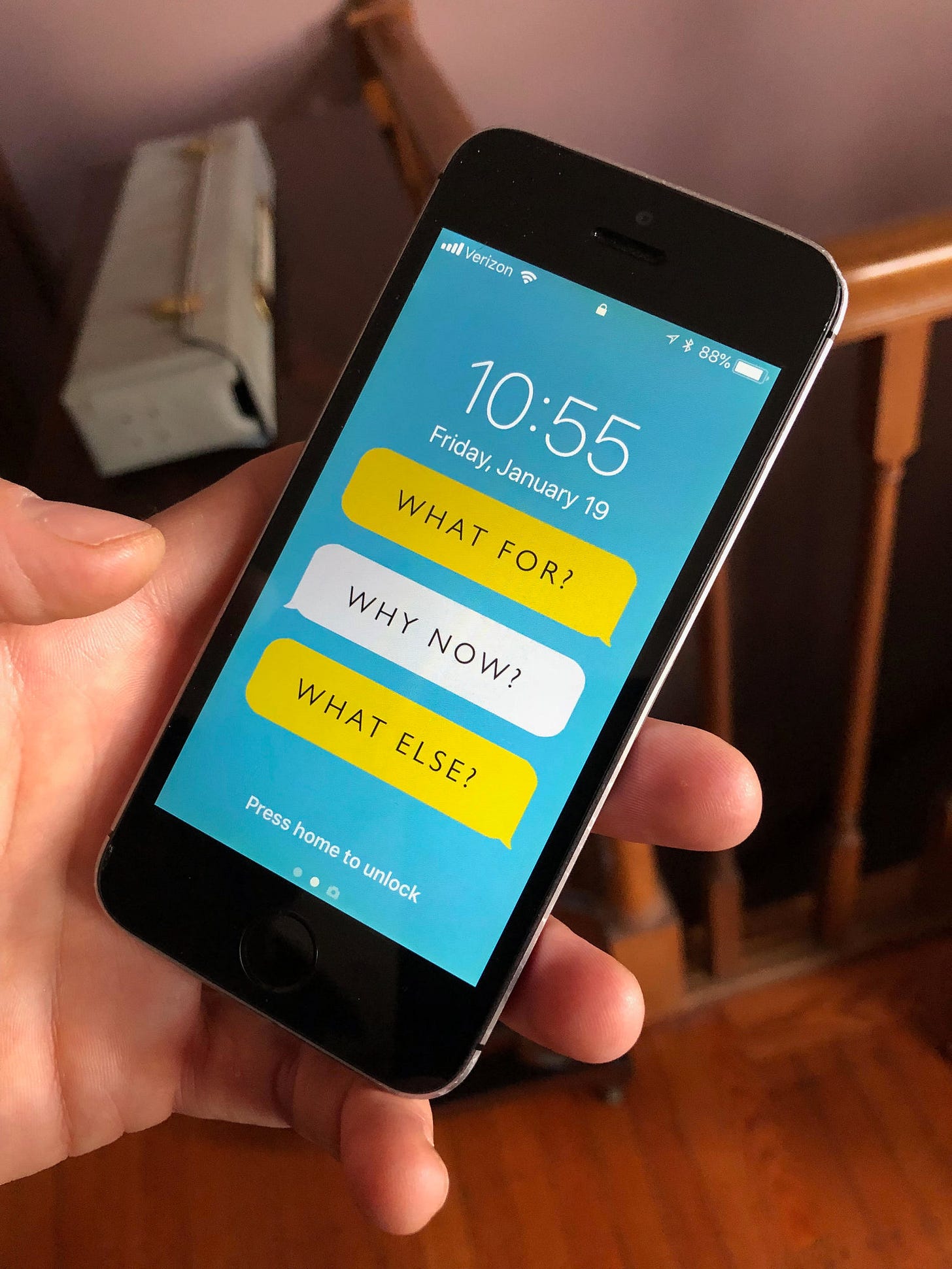How to Break Up With Your Phone
And why you probably should (plus, a special hello to Guardian and New York Times readers!)
It may perhaps sound obvious to point out that many of us have relationships with our phones that are not exactly what a couples therapist would describe as “healthy”—whether it’s because of the sheer amount of time we’re spending on them, or the emotional repercussions of consuming so much content that’s stressful, fear-inducing, and related to things that are ultimately out of our control.
Those are certainly some of the reasons that I wrote my book How to Break Up With Your Phone. I decided I wanted a relationship with better boundaries, and ended up spending the next year and a half researching habits, addiction, behavior change, mindfulness and neuroplasticity—plus the business incentives and design strategies of our most problematic apps—and developed a step-by-step plan for how to “break up” with my phone. The goal wasn’t to never use my phone again; it was to create a sustainable relationship that felt healthy.
Here are some of my key insights and less conventional tips for how to navigate a successful breakup (and makeup)—and create a healthier relationship with your phone.
For a more guided and comprehensive approach, check out my 30-day phone breakup course, which is based on my book and is somewhat cheekily designed to be delivered to you by — and on — your phone.
Start by asking yourself what you want to pay attention to
Here’s the thing: Our lives are what we pay attention to. That means that when we decide what to pay attention to in the moment, we are making a broader decision about how we want to spend our time alive. So instead of starting your phone breakup with a hack or a trick, first ask yourself: What do you want to pay attention to?
Separate the good from the bad
Just as there are different categories of food, there are different categories of things we do on our phones, and they’re not all bad; indeed many of the things that we use our phones for are practical, helpful, enjoyable, or even essential. Start by identifying the things you want or need to keep, and then think about what you’d like to reduce or eliminate.
Reframe the way you think about it
Many people equate spending less time on their phones with denying themselves pleasure — and who likes to do that? Instead, think of it this way: The time you spend mindlessly scrolling on your phone is time you’re not spending doing other more meaningful things, like hanging out with a friend or pursuing a hobby. Instead of thinking of it as “spending less time on your phone,” think of it as “spending more time on your life.”
Recognize that your desired level of control is not the same as your actual level of control
A lot of us check the news compulsively out of a feeling of moral obligation and the sense that if we do not immerse ourselves in current events (and contribute to threads on social media) then we are somehow irresponsible and uncaring. But please ask yourself: how is your involvement/immersion in current events helping the world? When you spend hours a day reading or listening to the news, is it doing any good for anyone? Or is it making you so upset and angry that you’re becoming less able to function in your own life — and therefore having a negative effect on your children, colleagues, loved ones, and everyone else you interact with? Does voicing outrage on social media help the people for whom you’re expressing outrage? Or is it just stoking the fire? We all are desperate for control, and want to believe that our personal consumption of the news or our comments on social media will change something, but in reality, the most common effect is to make us (and whomever we’re interacting with) more upset. I encourage you to try to limit your consumption of the news (via the internet, social media, radio and TV), and direct your energy toward things you actually have control over—and/or that make the world even just the tiniest bit better.
Don’t do unpaid work for someone else
Have you ever wondered why so many social media apps are free? It’s because advertisers are the customers — and your attention (and data) is what’s being sold. This means that whenever you spend time on attention-driven apps (such as social media), you are spending time making money for someone else. This is fine if one of your life’s goals is to help Mark Zuckerberg and Elon Musk get richer. But I kind of suspect that it’s not?
Set yourself up for success
Create triggers that will remind you of your goals and make it easier to live up to them. If you want to spend more time reading, leave a book on your bedside table. If you want to cook more, lay out a shopping list for that recipe you’re eager to try. Set up a charging station for your phone that’s not in your bedroom, and buy a stand-alone alarm clock.
On the flip side, avoid triggers that will set you up for failure. Delete social media apps from your phone. (Use the clunkier browser versions instead.) Disable notifications, including those for email. (I allow only those from phone calls, text messages and my calendar.) Establish a rule — for yourself and your family — of not keeping phones on the table during meals.
A word cloud based on the results of a survey I did about people’s biggest “problem apps”
Create speed bumps
It’s amazing how often we pick up our phones “just to check,” and then look up 20 minutes later wondering where the time has gone. I call these “zombie checks,” and they’re nearly guaranteed to be unsatisfying or make you feel like you’re wasting your life.
One solution is to create “speed bumps”: small obstacles that force you to slow down and make sure that when you do check your phone, it’s the result of a conscious choice. Put a rubber band around your phone as a physical reminder to pause, or create a lock screen image (see below) that asks you to confirm that you really want to proceed.
Pay attention to your body
When you notice that you’re in the midst of a phone spiral, ask yourself: What’s your posture like? How’s your breathing? Is whatever you’re doing on your phone making you feel good? Do you feel a sense of expansion in your body, or of constriction? The more tuned in you are to your own experiences in the moment, the easier it will be to change your behavior.
Pay attention to your brain
What are your emotions like when you spend time on your phone? What are your thoughts? Does scrolling through social media genuinely make you feel more connected to people you care about, or do you end up feeling anxious, insecure, and envious? Does checking the news leave you feel informed and empowered, or terrified and powerless? I think of my own phone as a Pandora’s box of possible emotions: I know I’m going to feel differently once I open it (and it’s usually not better!)—and once I let an emotional trigger out of my phone, I can’t stuff it back inside. Reminding myself of this often helps me put my phone down, or not check it in the first place.
Practice trial separations
Leave your phone at home while you go for a walk. Stare out of a window during your commute instead of checking your email. At first, you may be surprised by how powerfully you crave your phone. If so, don’t try to fight it; simply pay attention to your craving. What does it feel like in your body? What emotions is it bringing up? What are your thoughts? Keep observing your craving without engaging with it—or giving in to it—and eventually, you may find that, like a wave, it fades away on its own.
Use technology to protect yourself from technology
These days, most phones have a built-in time tracker that will show you how much of your one precious life you are spending on individual apps. (Prepare to be horrified.) App blockers such as Freedom let you block your access to problematic apps and websites when you want to take a break. Apple now has a “Do Not Disturb While Driving” mode that allows you to send customizable automated text message response (regardless of whether you’re driving) so that you can step away from your phone without worrying that you’ll leave someone hanging.
(I always hesitate to include too many specific tech/app suggestions, lest they become out-of-date — but please leave your own suggestions in the comments.)
Do the math
Look at the stats in your phone’s built-in time tracker, and then do the math to figure out the total amount of time you’re spending on your phone—or particular apps—in a year. For example, if you spend 2 hours a day on social media (which many people do), it adds up to a full month of your life. If you spend four hours a day on your phone (which, again, many people do) it’s two months—a quarter of your waking life, and the equivalent of 36 forty-hour work weeks. Pretty shocking, right?
Now imagine that you spent even a fraction of that time on something that you say you want to do but supposedly don’t have time for (for example, picking up a new hobby, learning a language or an instrument, spending time with your friends). How might your life improve if you redirected some of the time you’re currently spending on your phone?
Use the sight of other people on their phones as a reminder of your own intentions
Right now, the sight of someone else pulling out his or her phone on the elevator probably makes you want to check yours as well. But with practice, you can transform this into a cue for a new, healthier habit. When I see other people reach for their phones, I try to use it as a cue to take a deep breath and relax. (I’m successful most of the time.)
Get existential about it
If all else fails, consider your own mortality. How many people on their deathbeds do you think are going to say, “I wish I’d spent more time creating Instagram reels”?
So keep asking yourself the same question, again and again and again: This is your life. How much of it do you want to spend on your phone?
To scrolling less and living more,
author of How to Break Up With Your Phone: The 30-Day Plan to Take Back Your Life and The Power of Fun: How to Feel Alive Again
A version of this piece originally appeared in The New York Times.
The How to Break Up With Your Phone Course
Want more comprehensive guidance? Check out my 30-day SMS course, delivered right where you need it the most: on your phone. (Paid subscribers get 25% off.)
Paid Subscriber Bonus Tip/Resource: Lock and Home Screen Images For Your Phone
I find it useful to set my home and lock screen images to a reminder prompt (and to NOT have them show photos of my family or pets—because I don’t want my subconscious to internalize the idea that staring at my phone is the same as staring at my actual child).
I’ve made some images (such as the one above) that you can download and use on your own phone. To get them, please become a paid subscriber.







